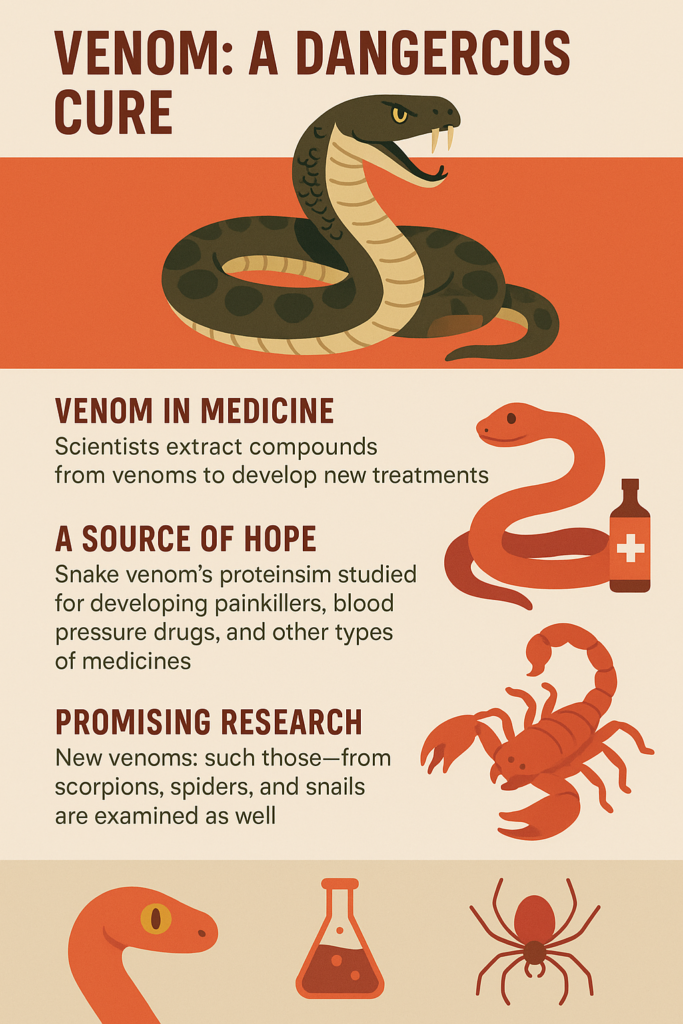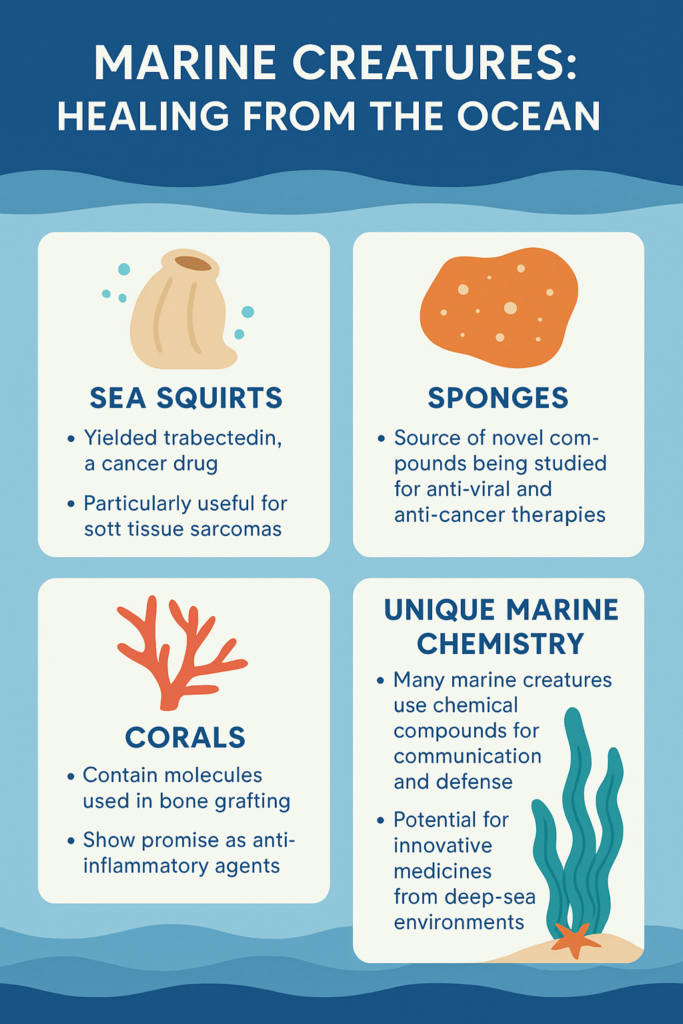How Animals Help Scientists Create New Medicines
Introduction:
The Wild Origins of Modern Cures
Medicine often conjures images of clinical labs, pills, and synthetic chemistry. But in many cases, the key ingredients in life-saving treatments come from the wild. Animals, through millions of years of evolution, have developed unique chemical compounds to survive, communicate, defend, or heal themselves. These natural defenses and adaptations serve as blueprints for scientists seeking innovative treatments for human diseases. This exploration of nature, known as bioprospecting, is helping to discover new drugs, especially at a time when antibiotic resistance and chronic diseases are on the rise.
Animals as Blueprints for Drugs
Nature is the original research lab. Biomimicry the practice of emulating nature’s time-tested patterns and strategies has guided drug discovery for decades. Scientists observe how animals survive in extreme conditions or ward off infections and use these insights to replicate similar mechanisms in medicine.
For instance, certain frogs produce antimicrobial peptides that help them stay infection-free in wet environments teeming with bacteria. These peptides can inspire new antibiotics that work against superbugs. Sharks, known for their robust immune systems and resistance to cancer, are being studied for immune-boosting compounds. Such adaptations, honed by evolution, provide clues for solving complex human health problems.
🐍 Venom: A Dangerous Cure
What’s deadly in nature might be healing in the lab. Venoms are rich in bioactive molecules that interact with the nervous, cardiovascular, and muscular systems. While venom can kill, its precision also makes it valuable in medicine. These toxins have been adapted into drugs for pain relief, blood pressure regulation, and blood thinning.
The Gila monster, for example, produces a hormone in its saliva that regulates glucose. This led to the development of exenatide, a drug for type 2 diabetes. The venom of the cone snail targets nerve channels and has been used to create Ziconotide, a potent painkiller for patients with severe chronic pain. Vipers, through their anticoagulant venom, inspired Captopril, a landmark blood pressure medication.
Researchers are currently investigating scorpion venom for its ability to mark cancerous cells in brain tumors, helping surgeons distinguish between healthy and cancerous tissue. Additionally, spider venom is being studied for its use in treating epilepsy and stroke due to its impact on ion channels in neurons.
These examples show that even the most dangerous creatures can save lives when studied responsibly.

🐌 Marine Creatures: Healing from the Ocean
The ocean covers over 70% of Earth’s surface and houses some of the most chemically diverse organisms. Marine animals often rely on unique compounds for defense or survival in the deep sea, where competition and predation are fierce.
Sea squirts, for example, produce Trabectedin, a compound used to treat soft tissue sarcomas and ovarian cancer. Sponges contain antiviral and anticancer agents like Halichondrin B, which inspired the chemotherapy drug Eribulin. Cone snails, apart from painkillers, also offer molecules with neurological applications. Even corals produce anti-inflammatory agents and molecules useful in bone grafting procedures.
Marine bacteria found in mollusks have also been identified as producers of new antibiotics. Horseshoe crabs, though not marine invertebrates in the traditional sense, are crucial for their blue blood, which contains Limulus Amebocyte Lysate (LAL) used to test vaccines and intravenous drugs for bacterial contamination.
Marine bioprospecting is still in its early stages, but its promise is vast. Protecting these habitats isn’t just an ecological issue it’s a medical one too.

Amphibians and Antibacterial Peptides
Amphibians live in moist, bacteria-rich environments that pose a constant threat of infection. To survive, many have evolved skin secretions rich in antimicrobial peptides. These natural antibiotics are often broad-spectrum and work rapidly making them a hot topic in medical research.
The Australian Green Tree Frog produces caerin peptides that kill bacteria without harming human cells. Scientists are exploring these peptides as a base for antibiotics that could combat antibiotic-resistant infections. Unlike traditional antibiotics, which often target specific bacterial functions, these peptides punch holes in bacterial membranes, making resistance harder to develop.
This line of research could be key in overcoming the global crisis of antibiotic resistance.
Bacteria, Bugs, and Unlikely Heroes
Even some of the creepiest crawlies have their place in modern medicine. Leeches, long used in ancient practices, are now standard tools in reconstructive surgeries. Their saliva contains hirudin, a powerful anticoagulant that prevents blood clots during recovery.
Maggots might sound unpleasant, but they selectively eat necrotic (dead) tissue, aiding in wound cleaning and promoting healing. They also secrete enzymes that combat infection and stimulate tissue regeneration.
Ticks and mosquitoes though notorious for spreading disease have saliva proteins that inhibit clotting and pain. These proteins are being studied for potential new blood thinners and immune-modulating drugs.
These unconventional sources remind us that solutions can come from the most unexpected places.
🧑🔬 How Scientists Study Animals Safely
Bioprospecting today is guided by ethical and sustainable practices. Modern researchers aim to collect samples non-invasively and avoid overexploitation of species. Many compounds can now be synthetically reproduced in labs, reducing the need for large-scale animal harvesting.
To prevent disrupting fragile ecosystems, scientists often rely on genomic sequencing, cell cultures, or CRISPR to study animal genes and recreate desired proteins without needing to extract them continuously. Venoms, for example, can now be replicated using DNA blueprints instead of milking live animals.
Collaboration with indigenous communities also ensures ethical sourcing. Many of these communities hold generations of ecological knowledge about the medicinal potential of native animals. Scientists work with them through benefit-sharing agreements, which help ensure cultural respect and economic equity.
By combining ethics with innovation, researchers are unlocking nature’s pharmacy while safeguarding biodiversity.
Ethical Concerns and Conservation Links
The link between wildlife and medicine raises critical ethical issues. Many species being studied for their medicinal potential are endangered. Should these species be exploited, even if the goal is to save human lives?
There’s also the issue of biopiracy, where corporations profit from indigenous knowledge without proper acknowledgment or compensation. Global frameworks like the Nagoya Protocol aim to ensure fair and equitable sharing of benefits arising from the use of genetic resources.
Ultimately, medical research must strike a balance between discovery and respect—for both nature and human cultures.
🐾 Animals That Already Saved Lives (and Might Again)
Here’s a snapshot of animal-based medical breakthroughs:
| Animal | Drug | Use |
|---|---|---|
| Gila Monster | Exenatide | Type 2 diabetes |
| Cone Snail | Ziconotide | Severe chronic pain |
| Viper | Captopril | High blood pressure |
| Sea Squirt | Trabectedin | Soft tissue cancer |
| Frog | Peptides | Antibiotic-resistant infections |
| Leech | Hirudin | Preventing blood clots |
| Maggot | Enzymes | Wound debridement and healing |
| Spider | Peptides | Experimental epilepsy treatments |
| Scorpion | Tumor paint | Identifying brain cancer boundaries |
| Shark | Immune proteins | Cancer and infection research |
Each of these animals holds clues that could unlock future cures. The list grows as researchers deepen their understanding of wildlife biology.
The Future: Synthetic Versions and New Frontiers
Rather than harvesting animals, scientists are now synthesizing these compounds in labs. Techniques like recombinant DNA technology, CRISPR, and artificial intelligence allow researchers to replicate animal proteins or discover new ones in databases without harming wildlife.
AI can predict how animal-derived molecules interact with human cells, speeding up drug discovery. Genomics helps in identifying useful genes that code for these proteins, which can be inserted into bacteria or yeast for safe, scalable production.
This synthetic approach ensures sustainability while maintaining innovation.
Conclusion:
Nature’s Lab Is Open 24/7
Animals from the tiniest insects to ocean giants offer a pharmacy full of secrets. Their natural abilities to survive, heal, and adapt provide vital clues for creating new medicines. The future of drug discovery may very well lie in the paws, wings, and fins of the natural world.
Preserving biodiversity is no longer just an environmental issue it’s a medical imperative. Because every species we lose might be a cure we’ll never find.